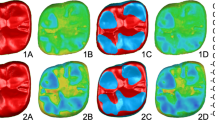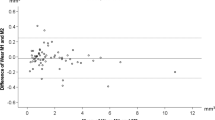Abstract
The objectives of this study were to measure the occlusal wear of composite resin denture teeth in patients wearing a complete denture and to evaluate factors affecting wear. Fifty participants provided with complete dentures in at least one jaw were included. Gypsum casts were made from preliminary vinyl polysiloxane impressions 4 weeks after insertion, then after 6 (t 1), 12 (t 2), and 24 months (t 3). Three-hundred and three posterior denture teeth were evaluated after 24 months. Wear was measured indirectly, from the casts, by means of a three-dimensional laser scanner device. Sequential images of the occlusal surfaces were digitized and superimposed (occlusal matching). Statistical analysis was performed by the use of mixed regression models, with the patient being a random effect. Mean wear (median, interquartile range; micrometer) of the entire occlusal surface was 8 (19) at t 1, 18 (34) at t 2, and 40 (61) at t 3. Maximum vertical loss (median, interquartile range; micrometer) was 92 (112) at t 1, 146 (148) at t 2, and 226 (184) at t 3. The dental status of the opposing jaw and the nature of the opposing material significantly affected the wear of denture teeth at t 3. Gender, daily wearing time, jaw, and type of tooth had no significant effects on the extent of wear. Clinically relevant vertical loss of composite resin denture teeth occurs after 24 months. Considering the limitations of this study, wear of denture teeth was affected by dental status and opposing material. The results suggest that wear of composite resin denture teeth exceeds that of enamel.




Similar content being viewed by others
References
Ogle RE, Davis EL (1998) Clinical wear study of three commercially available artificial tooth materials: thirty-six month results. J Prosthet Dent 79:145–151
Stober T, Lutz T, Gilde H, Rammelsberg P (2006) Wear of resin denture teeth by two-body contact. Dent Mater 22:243–249
Loyaga-Rendon PG, Takahashi H, Hayakawa I, Iwasaki N (2007) Compositional characteristics and hardness of acrylic and composite resin artificial teeth. J Prosthet Dent 98:141–149
Whitman DJ, McKinney JE, Hinman RW, Hesby RA, Pelleu GB Jr (1987) In vitro wear rates of three types of commercial denture tooth materials. J Prosthet Dent 57:243–246
Von Fraunhofer JA, Razavi R, Khan Z (1988) Wear characteristics of high-strength denture teeth. J Prosthet Dent 59:173–175
Douglas WH, Delong R, Pintado MR, Latta MA (1993) Wear rates of artificial denture teeth opposed by natural dentition. J Clin Dent 4:43–47
Hirano S, May KB, Wagner WC, Hacker CH (1998) In vitro wear of resin denture teeth. J Prosthet Dent 79:152–155
Suzuki S (2004) In vitro wear of nano-composite denture teeth. J Prosthodont 13:238–243
Ghazal M, Steiner M, Kern M (2008) Wear resistance of artificial denture teeth. Int J Prosthodont 21:166–168
Ghazal M, Yang B, Ludwig K, Kern M (2008) Two-body wear of resin and ceramic denture teeth in comparison to human enamel. Dent Mater 24:502–507
Ghazal M, Hedderich J, Kern M (2008) Wear of feldspathic ceramic, nano-filled composite resin and acrylic resin artificial teeth when opposed to different antagonists. Eur J Oral Sci 116:585–592
Reis KR, Bonfante G, Pegoraro LF, Conti PC, Oliveira PC, Kaizer OB (2008) In vitro wear resistance of three types of polymethyl methacrylate denture teeth. J Appl Oral Sci 16:176–180
Hahnel S, Behr M, Handel G, Rosentritt M (2009) Two-body wear of artificial acrylic and composite resin teeth in relation to antagonist material. J Prosthet Dent 101:269–278
Ghazal M, Albashaireh ZS, Kern M (2008) Wear resistance of nanofilled composite resin and feldspathic ceramic artificial teeth. J Prosthet Dent 100:441–448
Stober T, Henninger M, Schmitter M, Pritsch M, Rammelsberg P (2010) Three-body wear of resin denture teeth with and without nanofillers. J Prosthet Dent 103:108–117
Ogle RE, David LJ, Ortman HR (1985) Clinical wear study of a new tooth material: part II. J Prosthet Dent 54:67–75
Lindquist TJ, Ogle RE, Davis EL (1995) Twelve-month results of a clinical wear study of three artificial tooth materials. J Prosthet Dent 74:156–161
Jooste C, Geerts G, Adams L (1997) Comparison of the clinical abrasion resistance of six commercially available denture teeth. J Prosthet Dent 77:23–27
Ohlmann B, Rohstock K, Kugler J, Gilde H, Dreyhaupt J, Stober T (2007) Influences on clinical wear of acrylic denture teeth: a pilot study. Int J Prosthodont 20:496–498
Schmid-Schwap M, Rousson V, Vornwagner K, Heintze SD (2009) Wear of two artificial tooth materials in vivo: a 12-month pilot study. J Prosthet Dent 102:104–114
Heintze SD (2006) How to qualify and validate wear simulation devices and methods. Dent Mater 22:712–734
Lambrechts P, Debels E, Van Landuyt K, Peumans M, Van Meerbeek B (2006) How to simulate wear? Overview of existing methods. Dent Mater 22:693–701
Mehl A, Gloger W, Kunzelmann KH, Hickel R (1997) A new optical 3-D device for the detection of wear. J Dent Res 76:1799–1807
Ohlmann B, Trame JP, Dreyhaupt J, Gabbert O, Koob A, Rammelsberg P (2008) Wear of posterior metal-free polymer crowns after 2 years. J Oral Rehabil 35:782–788
Stober T, Dreyhaupt J, Lehnung U, Rammelsberg P (2008) Occlusal wear of metal-free ceramic-filled polymer crowns after 2 years in service. Int J Prosthodont 21:161–165
Palaniappan S, Bharadwaj D, Mattar DL, Peumans M, Van Meerbeek B, Lambrechts P (2009) Three-year randomized clinical trial to evaluate the clinical performance and wear of a nanocomposite versus a hybrid composite. Dent Mater 25:1302–1314
DeLong R (2006) Intra-oral restorative materials wear: rethinking the current approaches: how to measure wear. Dent Mater 22:702–711
Moriya Y, Tuchida K, Moriya Y, Sawada T, Koga J, Sato J, Nishikawa M, Takizawa T, Uematsu H, Ozaki T, Gionhaku N (1999) The influence of craniofacial form on bite force and EMG activity of masticatory muscles. VIII-1. Bite force of complete denture wearers. J Oral Sci 41:19–27
Miyaura K, Morita M, Matsuka Y, Yamashita A, Watanabe T (2000) Rehabilitation of biting abilities in patients with different types of dental prostheses. J Oral Rehabil 27:1073–1076
Abe Y, Sato Y, Akagawa Y, Ohkawa S (1997) An in vitro study of high-strength resin posterior denture tooth wear. Int J Prosthodont 10:28–34
Heintze SD, Zellweger G, Cavalleri A, Ferracane J (2006) Influence of the antagonist material on the wear of different composites using two different wear simulation methods. Dent Mater 22:166–175
Oh WS, Delong R, Anusavice KJ (2002) Factors affecting enamel and ceramic wear: a literature review. J Prosthet Dent 87:451–459
Ghazal M, Kern M (2009) The influence of antagonistic surface roughness on the wear of human enamel and nanofilled composite resin artificial teeth. J Prosthet Dent 101:342–349
Lambrechts P, Braem M, Vuylsteke-Wauters M, Vanherle G (1989) Quantitative in vivo wear of human enamel. J Dent Res 68:1752–1754
Perry R, Kugel G, Kunzelmann KH, Flessa HP, Estafan D (2000) Composite restoration wear analysis: conventional methods vs. three-dimensional laser digitizer. J Am Assoc 131:1472–1477
Acknowledgments
We thank Heraeus Kulzer, Hanau, Germany for financial support of this study. We also thank Ian Davies, copyeditor, for English language revision and Clemens Schmitt for assistance with measurement of wear.
Conflict of interest
The financial support of Heraeus Kulzer was used to compensate the patients for their additional effort attending recalls. The authors have no other financially beneficial arrangements with Heraeus Kulzer. The authors declare that they have no conflict of interest.
Author information
Authors and Affiliations
Corresponding author
Rights and permissions
About this article
Cite this article
Stober, T., Geiger, A., Rues, S. et al. Factors affecting wear of composite resin denture teeth—24-month results from a clinical study. Clin Oral Invest 16, 413–420 (2012). https://doi.org/10.1007/s00784-011-0534-y
Received:
Accepted:
Published:
Issue Date:
DOI: https://doi.org/10.1007/s00784-011-0534-y




